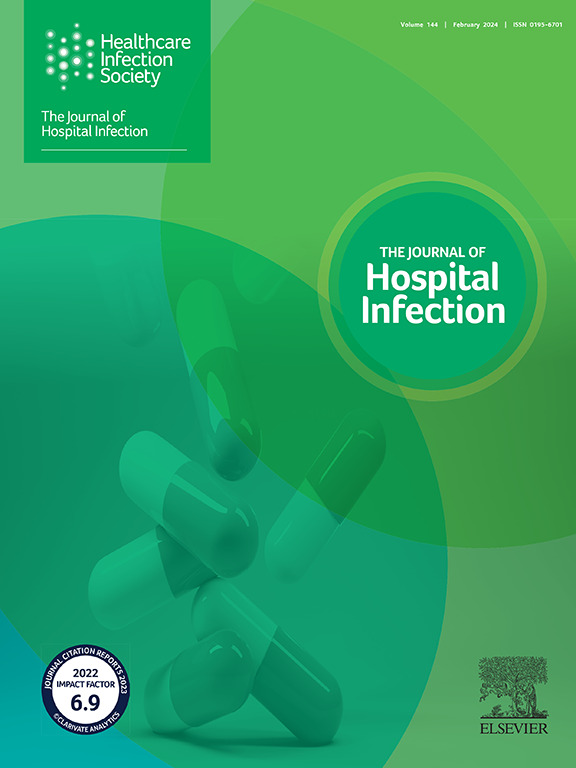Pathogenic bacteria rapidly colonize sinks of a neonatal intensive care unit: results of a prospective surveillance study
IF 3.9
3区 医学
Q1 INFECTIOUS DISEASES
引用次数: 0
Abstract
Background
Hospital sinks are known to harbour bacteria with the potential to infect patients.
Aim
To examine bacterial growth in the sinks of a newly constructed neonatal intensive care unit (NICU) during the transition from an established NICU within the same facility.
Methods
This was a prospective study of pathogenic bacterial growth in NICU handwashing sinks before and after the new NICU was occupied. Samples from various sink traps were cultured longitudinally, and comparison was made between the established NICU and the new NICU.
Findings
Potentially pathogenic bacteria colonized sinks rapidly in the new NICU within 1 month of occupation. During the study period, between 29th June 2021 and 2nd September 2022, 62 samples were collected from 11 sinks, of which 43 (69.4%) tested positive. The mean semi-quantitative bacterial growth score was notably higher in the sink in the milk preparation room compared with the sinks in the patient care area in the new NICU (40.67 vs 1.768; P=0.025). The bacterial profiles in the sink in the new NICU milk preparation room mirrored that of the established NICU, with a predominance of Klebsiella pneumoniae and Enterobacter cloacae complex. In handwashing sinks of both the established NICU and the new NICU, the dominant colonizing pathogen was Burkholderia cepacia complex, followed by Serratia marcescens and Elizabethkingia spp. Cessation of sink use reduced the bioburden of bacteria significantly in the NICU handwashing sink drains.
Conclusion
Handwashing sinks were colonized rapidly with pathogenic bacteria in a newly constructed NICU. More diversified and prolific growth of pathogenic bacteria was noted in the sink in the milk preparation room.
致病菌迅速定植新生儿重症监护病房水槽:一项前瞻性监测研究的结果。
背景:众所周知,医院的水槽内有可能感染病人的细菌。目的:检查新建新生儿重症监护病房(NICU)在同一设施内从已建立的NICU过渡期间水槽中的细菌生长情况。方法:对新入住新生儿重症监护病房前后新生儿重症监护病房洗手槽病原菌生长情况进行前瞻性研究。从不同的水槽中提取样本进行纵向培养,并将已建立的新生儿重症监护病房与新建的新生儿重症监护病房进行比较。发现:潜在的致病菌迅速定植水槽在新的新生儿重症监护病房一个月内占领单位。在2021年6月29日至2022年9月2日的研究期间,从11个汇收集了62个样本,其中43个(69.4%)检测呈阳性。新重症监护病房内,制奶室水槽的平均半定量细菌生长评分明显高于病人护理区水槽(40.67 vs. 1.768;P = 0.025)。新制奶室水槽中的细菌特征与已建立的新生儿重症监护病房的细菌特征一致,主要是肺炎克雷伯菌和阴沟肠杆菌复合物。在新建和已建新生儿重症监护室的洗手槽中,主要定植病原体为产绿伯克氏菌复群,其次是粘质沙雷氏菌和伊丽莎白菌。停止使用洗手池可显著降低新生儿重症监护病房洗手洗手池排水管中细菌的生物负荷。结论:新建新生儿重症监护病房洗手槽病原菌快速定植。在牛奶配制室水槽中发现了更多样化和多产的致病菌生长。
本文章由计算机程序翻译,如有差异,请以英文原文为准。
求助全文
约1分钟内获得全文
求助全文
来源期刊

Journal of Hospital Infection
医学-传染病学
CiteScore
12.70
自引率
5.80%
发文量
271
审稿时长
19 days
期刊介绍:
The Journal of Hospital Infection is the editorially independent scientific publication of the Healthcare Infection Society. The aim of the Journal is to publish high quality research and information relating to infection prevention and control that is relevant to an international audience.
The Journal welcomes submissions that relate to all aspects of infection prevention and control in healthcare settings. This includes submissions that:
provide new insight into the epidemiology, surveillance, or prevention and control of healthcare-associated infections and antimicrobial resistance in healthcare settings;
provide new insight into cleaning, disinfection and decontamination;
provide new insight into the design of healthcare premises;
describe novel aspects of outbreaks of infection;
throw light on techniques for effective antimicrobial stewardship;
describe novel techniques (laboratory-based or point of care) for the detection of infection or antimicrobial resistance in the healthcare setting, particularly if these can be used to facilitate infection prevention and control;
improve understanding of the motivations of safe healthcare behaviour, or describe techniques for achieving behavioural and cultural change;
improve understanding of the use of IT systems in infection surveillance and prevention and control.
 求助内容:
求助内容: 应助结果提醒方式:
应助结果提醒方式:


